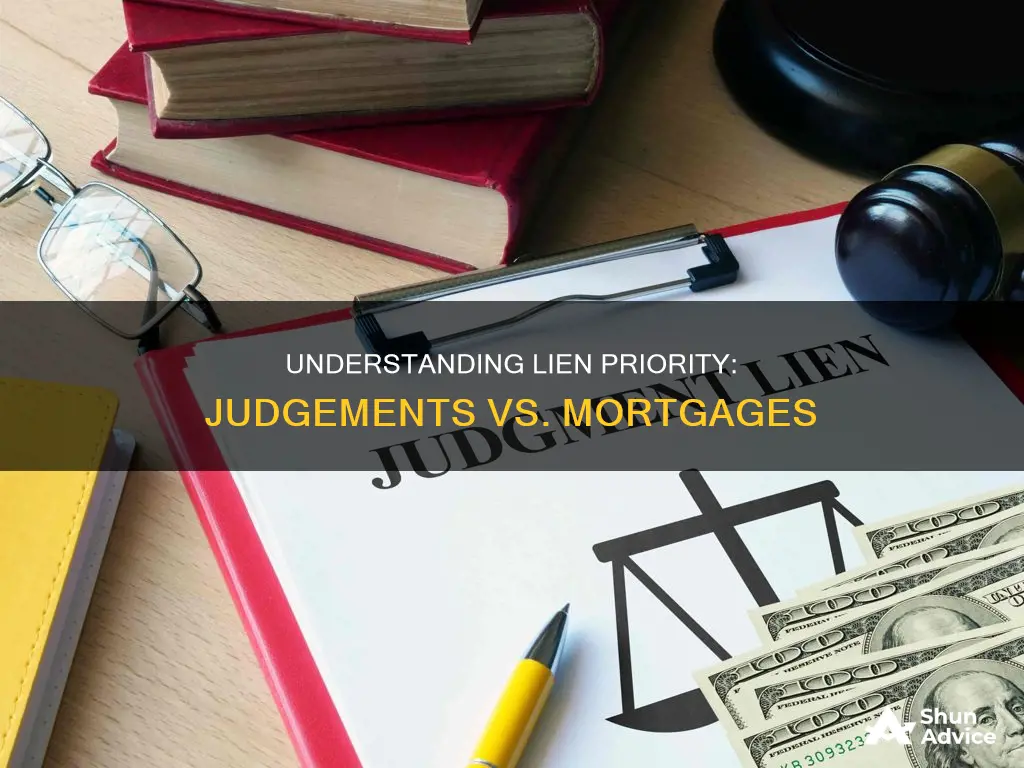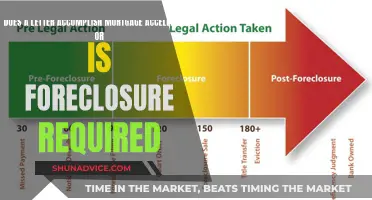
The priority of a lien determines the order in which creditors get paid following a foreclosure. A lien that has priority over another lien is called a superior lien, while a low-priority lien is called a junior lien. Generally, liens follow the first in time, first in right rule, which means that the lien recorded first in the land records has a higher priority than later-recorded liens. However, there are exceptions to this rule, and certain liens—like property tax liens, special assessment taxes, and mechanic's liens—can have priority over previously recorded liens. In the case of a judgement lien vs. a mortgage lien, a mortgage has priority over a judgement lien if the lender records it before the judgement creditor records its lien.
| Characteristics | Values |
|---|---|
| Lien priority | Determines the order in which creditors get paid following a foreclosure |
| First in time, first in right rule | Whichever lien is recorded first has a higher priority than later-recorded liens |
| Superior lien | A lien with priority over another lien |
| Junior lien | A low-priority lien |
| Voluntary liens | Mortgage liens |
| Involuntary liens | Judgment liens, tax liens, mechanic's liens |
| Non-mortgage liens | Rarely foreclosed due to the cost of foreclosing |
What You'll Learn

The 'first in time, first in right' rule
The "first in time, first in right" rule is a general rule in property law that determines the priority of liens on a property. It states that the lien that is recorded first in the land records has a higher priority than later-recorded liens. In other words, it means that when a property is sold, the creditor with the highest-priority lien gets paid first, followed by the second-priority lien holder, and so on, until the proceeds are exhausted. This is important because it determines which debts will be repaid first in the event of default and foreclosure.
For example, let's say a homeowner takes out a mortgage to buy a home. The lender records the mortgage in the county records, creating a lien on the property. This is known as a "first mortgage" or "first lien." If the homeowner then takes out another loan, such as a home equity loan, from a different lender, that lender will also record a lien on the property. This would be known as a "second mortgage" or "second lien." According to the "first in time, first in right" rule, the first mortgage would have priority over the second mortgage and would be paid first in the event of foreclosure.
It is important to note that there are exceptions to the "first in time, first in right" rule. Certain types of liens, such as property tax liens, special assessment taxes, and mechanic's liens, can have priority over previously recorded liens, depending on state law. These are known as "super liens." Additionally, in some states, homeowners' association (HOA) or condominium association (COA) liens may also have priority over first mortgages, even if the mortgage was recorded first.
The "first in time, first in right" rule also applies to tenants. If a mortgage is recorded against a property before a tenant enters into a lease, and the lender forecloses on the property, the lease should typically be terminated by the foreclosure. However, there may be exceptions to this, such as the Protecting Tenants at Foreclosure Act of 2009, which provides relief to tenants in certain situations.
Cosigner Rights: What Are They and Do They Matter?
You may want to see also

State law exceptions
State laws vary, and certain types of liens are prioritized over others depending on the state. Here are some examples of state law exceptions:
Property Tax Liens
In some states, property tax liens take priority over all other liens, including mortgage liens, regardless of when the lien was recorded. This is known as the super-priority of property tax liens. As a result, mortgage lenders may include the right to collect property taxes from the borrower in the loan agreement.
HOA and COA Liens
HOA and COA liens can also take priority over mortgages in some states. In these cases, the HOA or COA lien will be subordinate to a first mortgage, even if the mortgage was recorded after the association's lien.
Mechanics Liens
Mechanics liens, which are typically involuntary, can also take priority over mortgages in some states. This type of lien entitles contractors, subcontractors, and material suppliers to claim a lien on the real property and the improvements made to it.
State-Specific Exceptions
The state of Georgia, for example, uses a "security deed" as the most common contract for a lender to obtain a security interest in a property. This type of contract is considered a "first mortgage" and takes priority over most subsequently-recorded liens.
In California, a later-created Deed of Trust can take priority over an earlier one if certain conditions are met, including the earlier Deed not being recorded and the later beneficiary not having notice of the earlier lien.
Additionally, while tax liens and mortgage liens are distinct from judgment liens, it's important to note that plaintiffs do not need to revive tax or mortgage liens to maintain their priority.
Cosigner Impact: Can You Get a Higher Mortgage?
You may want to see also

Superior and junior liens
In the context of property and real estate law, liens are classified as either superior or junior liens, based on their priority. This priority dictates the order in which debts are paid off in the event of foreclosure or sale. Superior liens, also known as senior liens, take precedence over junior liens.
The "first in time, first in right" rule generally applies to liens, meaning that the lien recorded first in the land records has a higher priority than those recorded later. For example, a mortgage typically has priority over a judgment lien if the lender records it before the judgment creditor records its lien. However, there are exceptions to this rule. Certain types of liens, such as property tax liens, special assessment taxes, some HOA and COA assessment liens (called "super liens"), and mechanic's liens, can have priority over previously recorded liens, depending on state law.
A first mortgage, also known as a "first deed of trust," is a type of home loan that has priority over most subsequently recorded liens. In contrast, a second mortgage is recorded after a larger mortgage and secures the remaining balance. A judgment lien, which results from a court judgment, is usually inferior to a mortgage lien. However, if a homeowner fails to pay their HOA dues, the HOA may automatically get a lien on the home, which is often junior to the first mortgage.
The priority of liens is significant because it determines the lienholders' rights following a foreclosure sale. In a foreclosure sale, the finite amount of money generated may not be sufficient to cover all lienholders' claims. As a result, low-priority or junior lienholders may not receive any proceeds from the sale.
Divorce Decree and Mortgage: Who Takes Priority?
You may want to see also

Voluntary and involuntary liens
A lien is a claim to a property or asset. There are two main types of liens: voluntary and involuntary.
Voluntary liens are those where the owner of a property agrees to grant another party a legal claim to their property. This is often the only way to secure financing for the property. The most common examples of voluntary liens are mortgages on a home and liens placed on cars that are financed. A married couple, for instance, may take out a mortgage to buy a home, thereby placing a voluntary lien on the property until the mortgage is fully paid off. Once the debt is repaid, the lender no longer has a claim to the home, and the couple has full legal ownership.
Involuntary liens are liens that are placed on a property by an outside authority, such as a court or regulatory body, against the will of the owner. Common examples of involuntary liens include tax liens, judgment liens, homeowners' association (HOA) liens, municipal liens, and mechanic's liens. A tax lien, for instance, is issued by the government when taxes are owed. If the owner fails to pay income or property taxes, the Internal Revenue Service (IRS) will file an involuntary lien, alerting creditors that they have a right to the property.
Cosigner Impact: Mortgage Approval and Beyond
You may want to see also

The revival of judgment liens
In Illinois, a judgment from an Illinois state court or a federal court located in the state becomes a lien on real property after a certified copy or memorandum of the judgment is recorded in the county where the property is located. This recording is crucial even if the property is in the same county as the judgment's origin. Similarly, judgments from out-of-state courts can create liens in Illinois if specific requirements are met, including filing with the county clerk's office and providing relevant information.
Revival of judgment liens is a process that can be initiated by filing with the prothonotary of the county where the judgment was entered. This process ensures the continuation or creation of the lien's priority. In Pennsylvania, for instance, the rules outline the steps for reviving judgment liens, including the involvement of joint defendants and terre-tenants.
It is important to note that allowing a judgment lien to expire before revival can be risky. While a judgment lien can be revived within the 20-year statutory period, the creditor may lose lien priority if the revival is obtained after the initial seven-year lien period. This loss of priority occurs because the revived lien's priority is determined by the recording date of the order to revive, not the original judgment.
To summarise, the revival of judgment liens is a process that helps maintain the priority of the lien and ensures that creditors can receive their payments. However, it is essential to be mindful of the potential risks and the impact of other liens on the property.
Deed and Mortgage: What Does the Paper Trail Show?
You may want to see also
Frequently asked questions
No, a mortgage has priority over a judgement lien. This is because mortgages are considered voluntary liens, which means the homeowner chooses to put the lien on the home. Judgement liens are involuntary, meaning the lienor doesn't need the homeowner's consent before placing the lien.
The "first in time, first in right" rule states that whichever lien is recorded first has a higher priority than later-recorded liens. For example, if a mortgage is recorded before a judgement lien, the mortgage has priority.
In the case of NationsBanc Mortgage Corp. v. Sec. Bank & Trust Co., 600 N.W.2d 481 (Minn. Ct. App. 1999), a judgement lien was based on a judgement that had been docketed before the homestead was mortgaged. The court concluded that because the homestead exemption applied to the property, the judgement lien had priority.







